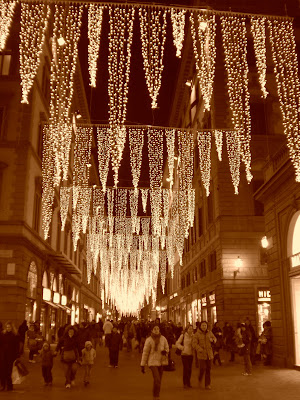.jpg) Old-world charm, anyone?
Old-world charm, anyone?
Friday, November 13, 2009
Wanderlust: Florence

 Those fortunate enough to live on the west side of the Arno--as seen here--have an unbelievable view of the Florence city-scape to the east. Jealousy overcomes us all.
Those fortunate enough to live on the west side of the Arno--as seen here--have an unbelievable view of the Florence city-scape to the east. Jealousy overcomes us all. Florence: A Rebirth, Again And Again
The Renaissance was just that: a rebirth. It ended centuries of western futility and stagnancy. How could one city--one!!-- and its transformation help cultivate the minds of Dante, DaVinci, Boccaccio, Michelangelo, Donatello, Galileo, Machiavelli, the Medici, and Raphael? Amazingly, this is a short list of people born in the city. The influence the city had throughout Europe cannot be quantified. Without this explosion of science, art, thought, exploration, etc., much of what we know today may not exist at all. How was all this possible? I don't know. Sometimes, it's best to just shut up and enjoy.
Today, Florence is a cultural gem. The Uffizi museum is a treasure chest of artistic accomplishments. The Ponte Vecchio is so precious that even the German army had implicit orders not to damage but a stone on its facade. The cobbled streets click and clack with the sound of high heals, as Florentine women--with their dark, sexy legs--somehow navigate over crack and crevice on their way to work. Even the air is filled with intoxicating scents. In autumn, the smell of homemade stock permeates the air, inviting us to eat and be merry.
Good food, unlike the art, is harder to find. That the city attracts millions of tourists a year means finding truly authentic food can be difficult. All it takes, fortunately, is a little patience. Walking the concrete forest of downtown, one can stumble upon a food vendor offering to its loyal patrons the delectable and delightful lampredotto--boiled cow stomach, often served with dry Tuscan bread and spicy salsa. It's rich and sinful and addictive, and it can only be found within Florence's walls. Watching important looking men in finely tailored suits gorging what was described as a medieval hamburger puts a smile on my face. In the home of chic style, Cavalli and Gucci, fine wine, commerce, and modern hotels, rusticity still trumps everything when it comes to food.
If Alaska is the pinnacle of nature's beauty, then Florence could be considered the pinnacle of man-made beauty. Bells and bridges and stone and stucco; libations and liver, piazze and ponti.
Cathedrals litter every corner, and they scream of magnificence and fulfillment. Each church attracts its own crowd. The Duomo--the ecclesiastical. Santo Spirito--the Bohemian. Santa Croce--the sophisticated. San Lorenzo--the scholarly. They all offer the traveler a different feel, a different look.
Statues of great men from long ago watch your every step. They stare at you, as you stare back at them. They're stoic and intimidating, and they make you question your own existence. Am I doing everything I could be doing? Am I contributing to my world? Florence is a tough place to think highly of yourself. Especially when you're standing in the shadow of men who thought higher.
Monday, November 9, 2009
Wanderlust: Seville
 Shade and a fan will be your best friends in Summer.
Shade and a fan will be your best friends in Summer. The fierce sun sets late, casting long and lazy shadows throughout the city.
The fierce sun sets late, casting long and lazy shadows throughout the city.The attention to detail in the architecture is remarkable.
Seville: The Tale Of Two Cities
Seville is a convergent city. It is the result of a cataclysmic clash of eastern and western cultures. At times, the city is ambivalent, vacillating between two worlds. Seville is both Spanish and Moorish, both Muslim and Christian, and the footprint of each culture is left--sometimes shallow, other times deep--in the city's architecture, gastronomy, art, and even the faces of of its inhabitants. It is one of those rare cities that is uniquely two things at once. One has the feeling that it takes two distinct lenses to view this single city. The challenge of viewing Seville is to see it as a whole, without compromising its individual parts.
Though Madrid and Barcelona often monopolize much of the country's tourism, Seville is a city that should not be overlooked. It's romantic, sexy, historic, and influential. This is where tapas are gorged, where Flamenco is adored, and where nights are wasted away drinking and conversing. Seville is more than just the capital of Andalusia--it is a capital of culture, a capital of beauty. This is evident in a perfectly crafted plate of ox tail, in the Moorish eyes of a woman assuaging the heat with a fan, or the tormented voice of a Sevillanas singer.
To truly appreciate Seville, one need only to wander the streets aimlessly, only occasionally seeking refuge from the heat in intricately and immaculately tiled buildings. The tiles, inspired by Arabic culture, cool the body as well as the eyes. It is also very necessary to admire the people. They're beautiful, and dark, and fluid in their movements. The women are wildly alluring. The men, intriguing. Even the children--either eating sophisticated food or playing happily on stoney streets--are a pleasure to watch. Only content and satisfied children can play so freely without toys and electronics.
In a city where Gothic spires of Catholic cathedrals cast lazy shadows on the facades of Moorish buildings, one can feel overwhelmed with all that must be seen. Take a deep breath. Relax. Sip your sherry and put up your feet. Have a long, hard look around you. Seville is a tale of two cities, and in the beginning, it will take two lenses to appreciate it. But, once you learn to see the city as a whole, you'll see it through the lens of a monocle--and all its beauty will be singular.
Subscribe to:
Comments (Atom)






.jpg)










